Probolomyrmex dammermani
| Probolomyrmex dammermani | |
|---|---|

| |
| Scientific classification | |
| Kingdom: | Animalia |
| Phylum: | Arthropoda |
| Class: | Insecta |
| Order: | Hymenoptera |
| Family: | Formicidae |
| Subfamily: | Proceratiinae |
| Tribe: | Probolomyrmecini |
| Genus: | Probolomyrmex |
| Species: | P. dammermani |
| Binomial name | |
| Probolomyrmex dammermani Wheeler, W.M., 1928 | |
Ito (1998) - Colonies of Probolomyrmex dammermani Wheeler were collected in West Java, Indonesia. The nests contained a few millipedes of the family Polyxenidae, all of which were completely divested of their covering setae. Laboratory experiments showed that the ants fed only on polyxenids. The following bionomic characteristics were also noted: colony size was small (14 workers on average; range 8–21) with one dealate queen who was mated and laid eggs; pupae were necked; and both workers and queens had only one ovariole per ovary. All nests were found in the soil at a depth from 3 to 5 cm.
Identification
Taylor (1965) - P. dammermani is closely related to the other Indo-Australian species, Probolomyrmex salomonis and Probolomyrmex greavesi. It is distinguished from them by the proportions of the node and the shape of its subpetiolar process. P. salomonis has a proportionately narrow head, and the antennal scapes of greavesi are somewhat shorter.
Eguchi et al. (2006) - In the worker this species is most similar to P. longinodus, but well distinguished from the latter by the relatively shorter petiole (LPtI < 135) and poorly developed propodeal teeth in the worker (see also Terayama & Ogata, 1988). In the male, P. dammermani is similar to Probolomyrmex longiscapus and Probolomyrmex longinodus, but the former can be separated from the latter two by the following characters: 1) thinner head in lateral view, 2) lower frontal carina, 3) narrower eye, and 4) narrower abdominal sternum IX and genitalia.
The nontype workers agree with the syntype worker. However, a certain variation is seen in the following characters: punctation on the body surface; convexity of lateral outlines of head in full-face view; concavity of occipital border (also mentioned by Taylor, 1965); development of posterior portion of subpetiolar process (also mentioned by Taylor, 1965); and development of posterolateral lamella of propodeum (sometimes forming a triangular propodeal spine). The flagellum is more slender in the worker and queen from Bali than in those from the other localities. Workers from colony Eg01iv06-08 are smaller, antennal scape shorter, and petiole in profile shorter (N=2; WL 0.69–0.73 mm, SI 89, LPtI 110) than in the material from the other localities (N=5; WL 0.88–0.96 mm, SI 103–117, LPtI 116–131).
Keys including this Species
Distribution
Latitudinal Distribution Pattern
Latitudinal Range: 19.667° to -8.133333°.
| North Temperate |
North Subtropical |
Tropical | South Subtropical |
South Temperate |
- Source: AntMaps
Distribution based on Regional Taxon Lists
Indo-Australian Region: Indonesia (type locality), Philippines.
Oriental Region: Thailand.
Distribution based on AntMaps
Distribution based on AntWeb specimens
Check data from AntWeb
Countries Occupied
| Number of countries occupied by this species based on AntWiki Regional Taxon Lists. In general, fewer countries occupied indicates a narrower range, while more countries indicates a more widespread species. |

|
Estimated Abundance
| Relative abundance based on number of AntMaps records per species (this species within the purple bar). Fewer records (to the left) indicates a less abundant/encountered species while more records (to the right) indicates more abundant/encountered species. |

|
Biology
Ito (1998) - One ovariole per ovary was found in both queens and workers (number of dissected individuals: 5 dealate queens, 4 alate queens, 20 workers). Workers had no spermatheca. Both males and females had wings. According to the classification by Ito and Ohkawara (1994), this species belongs to the AQ type in which only dealate queens are mated and lay eggs, while workers are always virgin. Morphology of larvae and pupae was similar to P. bolivensis (Taylor, 1965): larvae had a peculiar median suspensory tubercle on the terminal segment of the abdomen and pupae were naked without cocoons. In the artificial nests, larvae and pupae were attached to the glass ceiling of the brood chamber. As observed in Probolomyrmex boliviensis (Taylor, 1965), larvae were always attached by the tubercle of the abdominal tip, while pupae were attached by the head.
Four of five nests of P. dammermani contained one to six millipedes of the family Polyxenidae. The body length of these polyxenids was ca. two or more times that of the ants. All 11 polyxenids in the nests were completely divested of their covering setae, including caudal tufts as shown by Brandao et al. 1991, (Fig. 5) for the millipede prey of the ponerine ant Thaumatomyrmex. Two individuals in colony FI95-717 were alive although they were without setae. One polyxenid of colony FI95-517 had no setae and some legs had already disappeared. To discover food preference, several soil arthropods were given to laboratory colony FI95-517, including centipedes, termites, earwigs, spiders, isopods, and polyxenids. Only two polyxenids were brought into the nest chamber and were actually eaten by the adult ants and larvae. This result was consistent with the field observation that P. dammermani are specialized predators of Polyxenidae. In addition to the polyxenids, workers, males, and queens also fed on dead pupae and larvae of nestmates.
Hunting and the subsequent behavior were observed six times for three colonies in the laboratory. Foraging was always performed by single workers. When they encountered a polyxenid in the foraging arena, they approached it slowly from the side with the abdomen bent forward underneath the thorax. Then, the worker dashed toward the polyxenid, grasped its body, and stung. The worker then retrieved the paralyzed prey by pulling its antennae or legs or by holding the front part of the ventral appendages of the millipede and carrying the prey underneath its body. In the nest chamber, the prey was immediately stripped of setae by workers. Two or three workers frequently performed this task together. In general, a worker repeatedly grasped and pulled the setae with its mandibles for 1 to 3 minutes. Then, she went to the entrance or the corner of the nest chamber, where she abandoned the setae and frequently groomed her mandibles with the forelegs. Thus, the setae accumulated in the corner of the nest chamber and near the entrance. This behavior was repeated for 30 to 60 minutes, until stripping of the prey was completed. In colony FI95-717, a virgin dealate queen also showed this behavior with one of the two polyxenids. Alate queens, mated queens, and males never removed setae. After the prey were completely stripped, adult ants, together with the alate queens and the dealate queen started to feed; up to eight individuals fed on the prey together. After several minutes, the prey was separated into several small pieces. When the adults finished feeding, the workers gave the remains to the larvae.
Castes
Worker
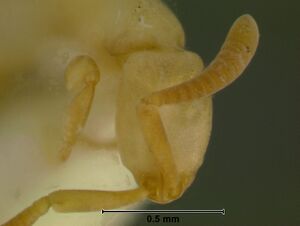 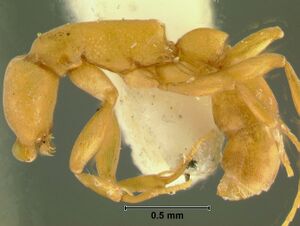 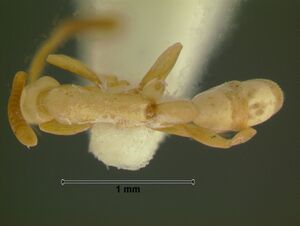 
| |
| . | Owned by Museum of Comparative Zoology. |
Male
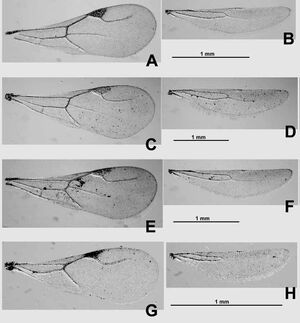 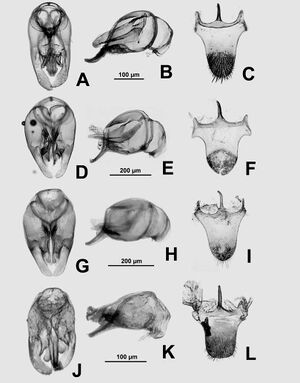
| |
| . | |
Nomenclature
The following information is derived from Barry Bolton's Online Catalogue of the Ants of the World.
- dammermani. Probolomyrmex dammermani Wheeler, W.M. 1928e: 7, fig. 1 (w.) INDONESIA (Java).
- Type-material: 4 syntype workers.
- Type-locality: Indonesia: Java, Buitenzorg (= Bogor), 18.xii.1922 (K. Dammerman).
- Type-depository: MCZC.
- [Note: MCZC has only 1 syntype; it is possible that the other 3 were returned to BZBC or MZBJ.]
- Eguchi, Yoshimura & Yamane, 2006: 7 (q.m.).
- Status as species: Chapman & Capco, 1951: 77; Taylor, 1965d: 356 (redescription); Brown, 1975: 11; Bolton, 1995b: 366; Jaitrong & Nabhitabhata, 2005: 41; Eguchi, Yoshimura & Yamane, 2006: 5 (redescription).
- Distribution: Indonesia (Bali, Java), Philippines (Negros), Thailand, Vietnam.
Unless otherwise noted the text for the remainder of this section is reported from the publication that includes the original description.
Description
Worker
Eguchi et al. (2006) - HL, 0.54–0.66 mm; HW, 0.35–0.42 mm; SL, 0.31–0.49 mm; CI, 63–67; SI, 89–117; WL, 0.69–0.96 mm; PW, 0.26–0.34 mm; DPtW, 0.15–0.19 mm; DPtI, 55–59; PtH, 0.21–0.26 mm; PtNL, 0.23–0.34 mm; LPtI, 110–131 (N=7).
Taylor (1965) - The following notes are based on a single syntype worker (labelled “cotype”) in the Museum of Comparative Zoology (type No. 26427). The general accuracy of Wheeler's original description has been confirmed by study of this specimen, but a few additions and corrections are indicated.
(1) HL, 0.60 mm.; HW, 0.41 mm.; SL, 0.42 mm.; Cl, 68; SI, 103; WL, 0.81 mm.; PW, 0.33 mm.; dorsal petiole width, 0.19 mm.; petiolar node index, 58; petiolar height, 0.25 mm.; petiolar node length, 0•30 nun.; lateral petiolar index, 120.
(2) First funicular segment of antenna about one-fifth longer than broad, and terminal segment one-quarter longer than the three preceding segments together.
(3) The two sculptural components normal for the genus present. Fine shagreening everywhere well developed, and overlying puncturation very distinct. Punctures of frons and dorsa of mesosoma, petiole and gaster about 0.01 mm. in diameter and spaced at about the same distance. Postgenal punctures, and those of sides of mesosoma and ventral and lateral aspects of petiole and gaster, larger, averaging about 0.02 mm. in diameter, and variously spaced, from intervals about equal to their maximum diameter to near contiguity.
(4) Mandibular dentition not visible, but apical two maxillary and terminal labial palpomeres with proportions similar to those of P. angusticeps.
Two additional worker specimens in the Museum of Comparative Zoology are apparently referable to P. dammermani and allow extension of its range to the Philippine Island of Negros. One of these is teneral, and was not measured; the other has the following dimensions: HL, 0.60 mm.; HW, 0.40 mm.; CI, 67; WL, 0.88 mm.; PW, 0.31 mm.; dorsal petiole width, 0.17 mm.; petiolar node index, 55; petiole height, 0.26 mm.; petiolar node length, 0.30 mm.; lateral petiolar index, 115. This specimen has lost its antennae, but the other has a scape index of about 100. The mandibular dentition consists of a single large apical tooth followed by a smaller preapical one and five small denticles. The palpal formula is maxillary 4: labial 2 (teneral dissected), with the segmental proportions as in P. angusticeps.
These specimens are very similar to the Javanese syntype in size, general form, sculpturation, pilosity and pubescence. The following slight differences from the syntype are noted: (1) the occipital border is somewhat less concave; (2) the posterior part of the subpetiolar process is more expanded (c.f. figs. 18 and 19); (3) the colour, even that of the less teneral specimen, is a much lighter yellowish-brown; this is almost - certainly due, however, to that specimen being partly callow.
Queen
Eguchi et al. (2006) - (alate and dealate queens). HL, 0.61–0.66 mm; HW, 0.42–0.44 mm; SL, 0.40–0.49 mm; EL, 0.11–0.13 mm; CI, 67–70; SI, 93–111; EI, 26–30; WL, 0.91–1.02 mm; PW, 0.37–0.38 mm; DPtW, 0.20 mm; DPtI, 53–54; PtH, 0.26–0.28 mm; PtNL, 0.30–0.33 mm; LPtI, 115–127 (N=3, but N=2 for DPtW and DPtI). Body ferruginous brown. Head in full-face view elongate, with very weakly convex sides and almost straight occipital border. Eye a little shorter than the width of apical antennal segment. Antennal scape when laid backward reaching or a little extending beyond the level of posterior margin of median ocellus; relative lengths of antennal segments II–XII as in the worker (see Fig. 10A); segment III almost as long as IV. Pronotum large; mesoscutum ca. 1.1–1.2 times as long as broad, in profile weakly convex; notauli absent; parapsidal lines very fine; scutoscutellar suture fine, very weakly and roundly curved posteriad; scutellum in profile with relatively steep posterior slope; axilla poorly separated from scutellum by an obscure impression but not by a suture; mesopleuron (except in its posteriormost part) well divided by a suture into anepisternum and katepisternum; raised median area of metanotum with gentle lateral slopes; suture between metepisternum and propodeum absent; a weak depression present dividing metepisternum into anepisternum and katepisternum; orifice of metapleural gland small, opening posterolaterad; posterior margin of propodeal dorsum in dorsal view moderately and broadly concave; posterior face of propodeum margined laterally with a well-developed translucent lamella which in profile forms an angle in upper portion. Petiole including subpetiolar process longer than high, in profile with very weakly concave posterior outline (above the articulation with gaster), in dorsal view gradually widened toward the midlength and parallel-sided in posterior half; posterodorsal margin of petiolar node in dorsal view almost straight or very weakly convex; subpetiolar process low, with an acute anterior projection and posteriorly with a low and sometimes obtusely angulate prominence. Abdominal segment III (gastral segment I) in profile relatively short, gently narrowed anteriad in the anterior 3/4 (in the queen from Bali the segment in profile a little slenderer). Wing structure and venation as in the male. Hind wing with three hamuli.
Male
Eguchi et al. (2006) - HL, 0.46–0.47 mm; HW, 0.46–0.47 mm; CI, 98–102; HD, 0.38–0.41 mm; HDI, 83–87; EL, 0.23–0.24 mm; SL, 0.30–0.32 mm; SI, 64–68; MstlL, 0.20–0.22 mm; MstlW, 0.20–0.23 mm; MstlI, 95–110; WL, 0.95 mm; PtNL, 0.28–0.32 mm; PtH, 0.16–0.20 mm; LPtI, 155–175 (N=3 but N=1 for WL). Head in lateral view relatively thin (HDI<90); protrusion of the frontoclypeal region relatively long, so that antennal insertion situated in the middle of its dorsal surface. Frontal carina low, not or slightly exceeding posterior margin of antennal insertions in full-face view. Eye relatively narrow, weakly widened ventrally. Antennal flagellum relatively long, filiform, with antennal segment III distinctly longer than segment II; segment XI (the third from apex) distinctly longer than broad; ventrolateral surface of the apical segment not concave. Mandible elongated triangular, with only a single strong apical tooth on its masticatory margin; basal angle distinct. Palpal formula: maxillary 4, labial 2; maxillary palp moderately long; the third palpomere distinctly longer than the second, and the apical distinctly longer than the third. With the mesosoma in lateral view, pronotum distinctly higher than mesoscutum; metanotum strongly produced posteriorly, and a suture separating it from mesoscutellum strongly notched; anepisternum of metapleuron separated from metakatepisternum and propodeum by a deep furrow; a suture between metakatepisternum and propodeum weak, but separation between the plates recognizable; dorsal margin of propodeum forming an angle with posterior slope. With the mesosoma in dorsal view, mesonotum lacking notauli; parapsidal lines distinct; axillae distinct; mesoscutellum slightly broader than long; declivitous face of the propodeum very slightly concave with weak, obtuse lateral lamellae. Petiole in lateral view without a distinct peduncle; node long with gentle anterior slope and steep posterior slope; posterodorsal margin angular; subpetiolar process narrowly developed with its apex sharp. Abdominal sternum IX long, with its apical margin gently pointed medially. Genitalia retractile. With the phallus in lateral view, the basal ring moderately long and its dorsal margin gently declined; dorsal margin of the basiparamere gently raised in its basal portion; posterodorsal slope gentle; digitus volsellaris simply curved ventrally in its apical portion; penis valve relatively thick and nearly straight, not strongly narrowed apically, and its apical portion blunt and slightly curved ventrally. Paramere thin; its expanded inner faces directed ventrally, of which apical portion is curved dorsally. Aedeagal apodeme relatively narrow. On fore wing, costa and radius apical to stigma vestigial; Rsf2 and Rsf3 completely absent; radial sector never reaching costal margin; Mf1, Rs+M and media apical to Rs+M present; cu-a cross vein present. On hind wing, Rsf4+5 present; jugal lobe absent.
Type Material
Eguchi et al. (2006) - Syntypes: 4 workers, Buitenzorg [Bogor], Java, Indonesia, 18/xii/1922, K. Dammerman (Museum of Comparative Zoology) [one worker examined].
References
- Brassard, F., Leong, C.-M., Chan, H.-H., Guénard, B. 2021. High diversity in urban areas: How comprehensive sampling reveals high ant species richness within one of the most urbanized regions of the world. Diversity 13, 358 (doi:10.3390/d13080358).
- Eguchi K. Yoshimura M. and Yamane S. 2006. The Oriental species of the ant genus Probolomyrmex (Insecta: Hymenoptera: Formicidae: Proceratiinae). Zootaxa 1376:1-35.
- Ito, F. 1998. Colony composition and specialized predation on millipedes in the enigmatic ponerine ant genus Probolomyrmex (Hymenoptera, Formicidae). Insectes Sociaux. 45:79-83.
- Ito, F., Hosokawa, R. 2020. Biological notes of Probolomyrmex okinawaensis Terayama & Ogata collected in Yonagunijima Island, and five species of Probolomyrmex collected in Japan and Southeast Asia. Asian Myrmecology 12, e012003 (doi:10.20362/am.012003).
- Taylor, R. W. 1965d. A monographic revision of the rare tropicopolitan ant genus Probolomyrmex Mayr (Hymenoptera: Formicidae). Trans. R. Entomol. Soc. Lond. 117: 345-365 (page 356, see also)
- Wheeler, W. M. 1928e. A new species of Probolomyrmex from Java. Psyche (Camb.) 35: 7-9 (page 7, fig. 1 worker described)
- Yamane, S., Tanaka, H.O., Hasimoto, Y., Ohashi, M., Meleng, P., Itioka, T. 2021. A list of ants from Lambir Hills National Park and its vicinity, with their biological information: Part II. Subfamilies Leptanillinae, Proceratiinae, Amblyoponinae, Ponerinae, Dorylinae, Dolichoderinae, Ectatomminae and Formicinae. Contributions from the Biological Laboratory, Kyoto University 31, 87–157.
References based on Global Ant Biodiversity Informatics
- Brown W. L., Jr. 1975. Contributions toward a reclassification of the Formicidae. V. Ponerinae, tribes Platythyreini, Cerapachyini, Cylindromyrmecini, Acanthostichini, and Aenictogitini. Search Agric. (Ithaca N. Y.) 5(1): 1-115.
- Chapman, J. W., and Capco, S. R. 1951. Check list of the ants (Hymenoptera: Formicidae) of Asia. Monogr. Inst. Sci. Technol. Manila 1: 1-327
- Eguchi K.; Yoshimura M.; Yamane S. 2006. The Oriental species of the ant genus Probolomyrmex (Insecta: Hymenoptera: Formicidae: Proceratiinae). Zootaxa 1376: 1-35.
- Eguchi, K., M. Yoshimura, and S. Yamane. "The Oriental species of the ant genus Probolomyrmex (Insecta: Hymenoptera: Formicidae: Proceratiinae)." Zootaxa 1376 (2006): 1-35.
- Ito F. 1998. Colony composition and specialized predation on millipedes in the enigmatic ponerine ant genus Probolomyrmex (Hymenoptera, Formicidae). Insectes Sociaux 45: 79-83.
- Ito, F.; Yamane, S.; Eguchi, K.; Noerdjito, W. A.; Kahono, S.; Tsuji, K.; Ohkawara, K.; Yamauchi, K.; Nishida, T.; Nakamura, K. 2001. Ant species diversity in the Bogor Botanic Garden, West Java, Indonesia, with descriptions of two new species of the genus Leptanilla (Hymenoptera, Formicidae). Tropics 10:379-404.
- Jaitrong W., and T. Ting-Nga. 2005. Ant fauna of Peninsular Botanical Garden (Khao Chong), Trang Province, Southern Thailand (Hymenoptera: Formicidae). The Thailand Natural History Museum Journal 1(2): 137-147.
- Jaitrong W.; Nabhitabhata, J. 2005. A list of known ant species of Thailand. The Thailand Natural History Museum Journal 1(1): 9-54.
- Philpott S.M., P. Bichier, R.A. Rice, and R. Greenberg. 2008. Biodiversity conservation, yield, and alternative products in coffee agroecosystems in Sumatra, Indonesia. Biodivers. Conserv. 17: 1805-1820. Data obtained from Stacy Philpott
- Taylor R. W. 1965. A monographic revision of the rare tropicopolitan ant genus Probolomyrmex Mayr (Hymenoptera: Formicidae). Transactions of the Royal Entomological Society of London 117: 345-365.
- Wheeler W. M. 1928. A new species of Probolomyrmex from Java. Psyche (Cambridge) 35: 7-9.
- Wheeler, W. M. "A new species of Probolomyrmex from Java." Psyche 35 (1928): 7-11.
- Yamane S.; Nona, A. R. 1994. Ants from Lambir Hills National Park, Sarawak. Pp. 222-226 in: Inoue, T.; Hamid, A. A. (eds.) 1994. Plant reproductive systems and animal seasonal dynamics. Long-term study of dipterocarp forests in Sarawak. Kyoto: Center for Ecological Research, Kyoto University, vii + 255 pp.



